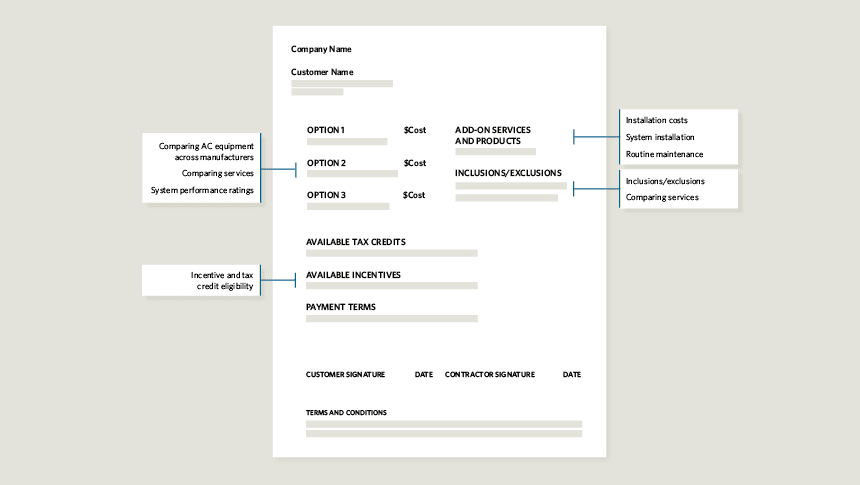Not all contractor bids are the same and sometimes the information can be confusing. In this article, we’ll show you what to look for in a contractor bid for a central air conditioner and how to compare bids from different contractors to make the most informed decision when hiring someone to install your equipment.
Sample bid

Comparing air conditioning equipment across manufacturers
As you collect bids from multiple contractors, you will likely have to decide between different manufacturers. Each contractor likely sells multiple brands of equipment to their customers. Understanding the difference between each of the popular manufacturers can be very difficult. Manufacturers and their associated dealers (contractors) are very good at selling their specific equipment (that’s their job!). Beyond referring to third-party consumer report-style websites, you can look for other distinguishing factors:
- Length of warranty: Look for warranty length as well as labor (the cost of having a contractor perform a repair) vs. parts (the cost of physical components being replaced). Some warranties will also limit coverage to specific components.
- Price vs. value: Some air conditioning equipment offers more bells and whistles that typically come at a cost. Examples of these upgrades include reduced noise during operation, enhanced temperature and humidity controls, advanced air filtration system, and a wider range of cooling output (improving performance and reducing operational cost). Talk to your contractor about any special features and how they will affect you and your home. They can help you decide if the value is equivalent to the cost.
- Efficiency ratings: Central air conditioners are rated by Seasonal Energy Efficiency Ratio and Energy Efficiency Ratio (SEER2 and EER2) for cooling efficiency. The higher the rating, the less energy the system is designed to use throughout the cooling season. This can be a valuable distinguishing factor when comparing brands and models.
- Compatibility with existing heating systems: If you are not planning on having a new heating system installed with your central air conditioner, ask the contractor if the new unit will be a good match for your existing furnace.
- Incentive and tax credit eligibility: Your bid, if eligible, may include an Energy Trust of Oregon incentive amount and available tax credits for each unique system being proposed. If you do not see any mention of incentives and/or tax credits, double check with the contractor(s) before comparing total costs between each of the bids. Be sure to have any promised credits listed out in writing before signing the bid.
Comparing services
When comparing bids, it’s important to remember that you’re also hiring a company to perform the installation. Look out for services included and not included that can impact the overall performance of your cooling system. Some key services include:
- Heat gain calculation: This is a very important part of designing an air conditioning system that is right for your specific home. Contractors should complete an analysis of your home including wall, floor and window measurements, insulation levels and other energy-related components. A heat gain calculation will ensure the contractor is choosing a properly sized system. An oversized system will likely cycle on and off too frequently, significantly reducing energy efficiency and putting extra strain on various parts. An undersized system will struggle to maintain desired temperature on the hotter days.
- Confirming condition of ducts: When having a new central cooling system installed that transfers air through ducts, it is important to know your contractor has reviewed the condition of the ducts. This assessment should occur before they provide a bid for their services. Even if they are not prepared to make improvements to the duct system, you want to be confident that your new cooling system is able to deliver air sufficiently throughout your home. This is especially important if your ducts travel through an attic or crawlspace, as both energy loss and air quality can be significantly impacted by duct leaks and insufficient insulation. Don’t hesitate to ask your contractor if they performed an assessment of the ducts in your home before moving forward with the installation.
Installation costs
Central air conditioning installation costs can vary significantly, both by the contractor and across different installation locations. As previously mentioned, be sure to thoroughly review the estimates provided by the contractors bidding on your project and compare what is included in the description of services. While coming at an additional cost, there are optional services and features that could make or break the performance of your central air conditioner. Examples of the factors that could negatively impact the AC performance include a poorly-mounted outdoor unit, ducts in unconditioned areas without sealing or insulation and poorly designed air filtration. Features that can enhance the performance of the AC system include energy or heat recovery ventilation and enhanced controls (thermostats).
Cost of operation
The costs associated with a central air conditioner are not limited to the initial installation costs. The amount of money spent to power the system, better known as the operating cost, is just as important. While there isn’t a way to predict the exact cost of operating your new central air conditioner, there are six key factors that influence this cost.
- System settings and customer behavior: Central air conditioning controls (thermostats) often have settings that prioritize either comfort or efficiency. Comfort settings may push the system to run harder for longer stretches of time, which costs more to operate. Customers also play a key role in how they adjust the thermostat settings during the cooling season. Avoiding significant swings in temperature (greater than 3–5° F) allows your air conditioner to operate with higher efficiency, similar to how a car uses less gas when cruising at a consistent speed vs. frequent braking/acceleration. Smart thermostats can help the user choose an energy-efficient mode of operation, but it is important to consult the central air conditioning installer before switching to a smart thermostat. Some systems need to be paired with a very specific thermostat in order to operate properly.
Site preparation
Often the focus starts and stops with the core components of the air conditioner when planning for a new system. However, the readiness of the home itself should also be considered, preferably before a specific model/size is chosen.
- Thermal and air leakage of a home: Air conditioners have to produce more conditioned air when the house is poorly insulated and/or has a high level of air leakage. This can result in higher operational costs and can require a larger-sized air conditioner, which also costs more. Energy Trust recommends you consult a professional to verify the amount of insulation in your attic, exterior walls and floor. Also, consider upgrading your windows if you currently have single-pane and/or aluminum-frame windows.
- Read more about insulation options and find incentives. Learn about high-efficiency windows and available incentives.
System installation
The quality of your installation can have as much, if not even more of an impact on the performance of your system than the choice of equipment. A properly installed entry level central air conditioner could easily cost less to operate than a poorly installed top-of-the-line, high-efficiency unit. A properly installed central air conditioner involves:
- Proper sizing (see “heat gain calculation” mentioned earlier)
- Technician-verified refrigerant charge, air flow, amp draw and line-set (ask your installer to describe the steps they take during the installation to verify it is functioning properly).
- Inspection of ducts: Ensuring no obstructions and that ducts located in unconditioned areas are sealed and insulated.
- AHRI-matching components: If you do not see a reference to AHRI (Air Conditioning, Heating and Refrigeration Institute) on your proposal, ask your contractor if they can provide this information. AHRI is an industry resource that lists matching HVAC equipment and the corresponding performance ratings for each unique match.
- Routine maintenance: Central air conditioning systems rely on clean filters, clean coils and unobstructed outdoor units to function properly. Be sure to follow the manufacturer and installer maintenance instructions and to have your unit serviced annually by an HVAC contractor.
- Cost of electricity: As the price of electricity fluctuates, so will the cost to operate your central air conditioner. You can find the overall amount of electricity your home uses as well as the cost/kWh on your monthly utility bill statement to see if an unusually high bill is due to an increase in usage or rising fuel costs. A mysterious spike in electricity costs could also be the result of a system malfunction.
- System performance ratings: As mentioned earlier, your contractor will likely present the SEER2 and EER2 efficiency ratings on the proposal. The higher the rating, the less energy the system is designed to use.
Inclusions/exclusions
Inclusions are services that are included in the project for the quoted amount. Exclusions are services that are not included. Exclusions listed on your bid may include removing or recycling existing equipment, replacing an existing air handler or modifying electrical components. These are primary services that the contractor is not agreeing to perform. It is important to ask your contractor if they believe you will need any of these services to complete the project.
- Reminder: While contractors may clearly call out services or products that are not included, it is also safe to assume that when something is not mentioned at all, it probably means it is not included. It is your responsibility to have the services you expect in writing before signing the bid. This includes expectations around site clean-up at the end of the day/project, permit costs, warranty coverage (labor vs. parts) and rebate/incentive support. If you see something called out on one contractor’s bid, but not included on another contractor’s bid, this is a good opportunity to ask why.
- Contingency and unforeseen conditions: A contingency fee is often a specified percentage of the overall project cost listed as a separate line item in the bid and reserved for unforeseen circumstances. Example: If you hire a contractor to complete a job that is priced at $10,000, and they have a 10% contingency fee added to the bid, your maximum project cost is $11,000. If the contractor is able to complete the project without running into unforeseen circumstances, there will likely be contract language requiring the contractor to reduce the final project cost by that $1,000 amount.
Unforeseen circumstances typically involve site-specific conditions that were not evident when the original project scope was priced out and must be dealt with to continue the work. Examples could include mold hiding behind a wall, damaged electrical wiring obscured by insulation or termite damage to structural wood framing. It is important to discuss with your contractor how they will communicate with you before either completing the extra work and tacking on additional costs to your invoice, or potentially dipping into a contingency fee.
Get started
Ready to start gathering bids for your central air conditioning project? Use our search tool to find an Energy Trust approved trade ally contractor near you.
Air conditioner savings
Find incentives for qualified central air conditioning systems.



